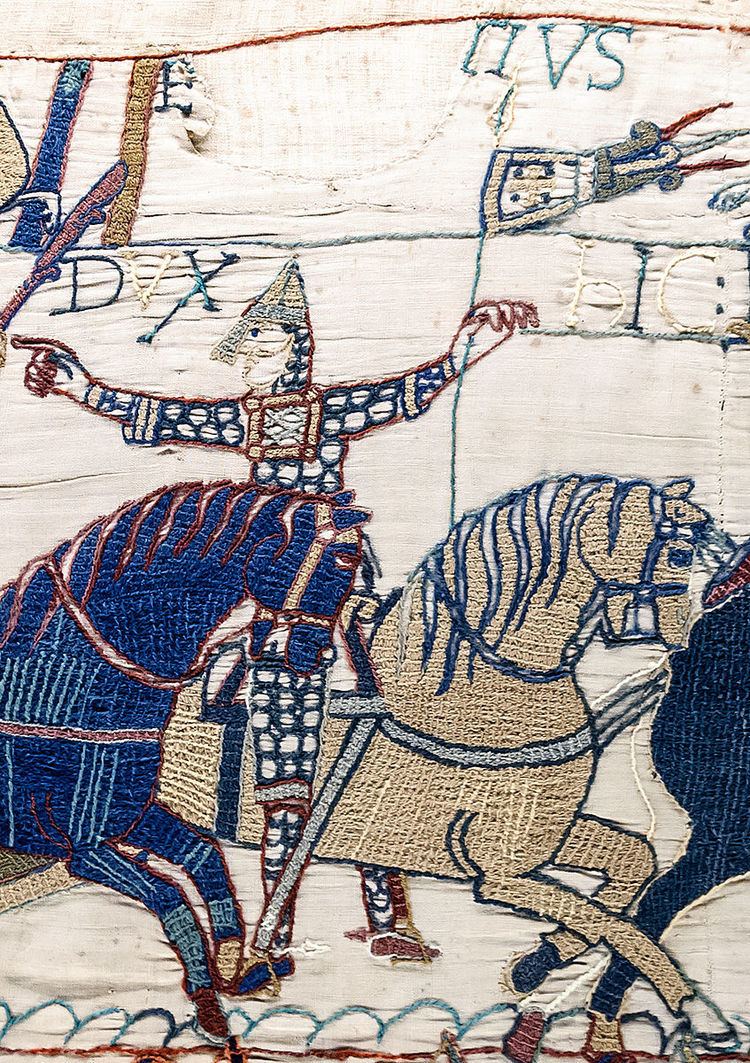Died 1087 Father Eustace I of Boulogne | Mother Matilda of Leuven Name Eustace Count | |
 | ||
Parents Eustace I, Count of Boulogne Children Godfrey of Bouillon, Eustace III, Count of Boulogne, Baldwin I of Jerusalem Similar People Godfrey of Bouillon, Baldwin I of Jerusalem, Lambert II - Count of Lens, AEthelred the Unready, Emma of Normandy | ||
Grandchildren Matilda of Boulogne | ||
Eustace ii count of boulogne
Eustace II, (c. 1015 – c. 1087), also known as Eustace aux Gernons (with moustaches) was Count of Boulogne from 1049–1087. He fought on the Norman side at the Battle of Hastings, and afterwards received large grants of land forming an honour in England. He is one of the few proven companions of William the Conqueror. It has been suggested that Eustace was the patron of the Bayeux Tapestry.
Contents
- Eustace ii count of boulogne
- Origins
- Career
- Fights at Battle of Hastings
- Rebellion
- Death
- Marriage and progeny
- Cinematic depictions
- References
Origins
He was the son of Eustace I of Boulogne.
Career
In 1048 Eustace joined his father-in-law's rebellion against the Emperor Henry III. The next year Eustace was excommunicated by Pope Leo IX for marrying within the prohibited degree of kinship. Eustace and Ida were both descended from Louis II of France, and just within the prohibited seventh degree. However, since today not all their ancestors are known, there may have existed a closer relationship. The Pope's action was possibly at the behest of Henry III. The rebellion failed, and in 1049 Eustace and Godfrey submitted to Henry III.
Eustace visited England in 1051, and was received with honour at the court of Edward the Confessor. Edward and Eustace were former brothers-in-law and remained political allies. On the other side of the political divide the dominant figure in England was Earl Godwin, who had recently married his son Tostig to the daughter of Eustace's rival the Count of Flanders. Furthermore, Godwin's son Sweyn Godwinson had been feuding with Eustace's stepson Ralph the Timid.
A brawl in which Eustace and his servants became involved with the citizens of Dover led to a serious quarrel between the king and Godwin. The latter, to whose jurisdiction the men of Dover were subject, refused to punish them. His lack of respect to those in authority became the excuse for his being outlawed together with his family. They left England, but returned the next year in 1052 with a large army, aided by the Flemish.
In 1052 William of Talou rebelled against his nephew Duke William of Normandy. Eustace may well have been involved in this rebellion, although there is no specific evidence, for after William of Talou's surrender he fled to the Boulonnais court.
The following years saw still further advances by Eustace's rivals and enemies. Count Baldwin of Flanders consolidated his hold over territories he had annexed to the east. In 1060 he became tutor of his nephew King Philip I of France. In contrast Eustace's stepson Walter of Mantes failed in his attempt to claim the County of Maine. He was captured by the Normans and died soon afterwards in mysterious circumstances.
Fights at Battle of Hastings
These events evidently caused a shift in Eustace's political allegiances, for he then became an important participant in the Norman conquest of England in 1066. He fought at Hastings, although sources vary regarding the details of his conduct during the battle. The contemporary chronicler William of Poitiers wrote concerning him:
With a harsh voice he (Duke William) called to Eustace of Boulogne, who with 50 knights was turning in flight and was about to give the signal for retreat. This man came up to the Duke and said in his ear that he ought to retire since he would court death if he went forward. But at the very moment when he uttered the words Eustace was struck between the shoulders with such force that blood gushed out from his mouth and nose and half dead he only made his escape with the aid of his followers.
The depiction in the Bayeux Tapestry shows a knight carrying a banner who rides up to Duke William and points excitedly with his finger towards the rear of the Norman advance. William turns his head and lifts up his visor to show his knights following him that he is still alive and determined to fight on. This conforms therefore with Eustace having somewhat lost his nerve and having urged the Duke to retreat whilst the Battle was at its height with the outcome still uncertain. Other sources suggest that Eustace was present with William at the Malfosse incident in the immediate aftermath of the battle, where a Saxon feigning death leapt up and attacked him, and was presumably cut down before he could reach William.
Eustace received large land grants afterwards, which suggests he contributed in other ways as well, perhaps by providing ships.
Rebellion
In the following year, probably because he was dissatisfied with his share of the spoil, he assisted the Kentishmen in an attempt to seize Dover Castle. The conspiracy failed, and Eustace was sentenced to forfeit his English fiefs. Subsequently he was reconciled to the Conqueror, who restored a portion of the confiscated lands.
Death
Eustace died circa 1087, and was succeeded by his son, Eustace III.
Marriage and progeny
Eustace married twice:
By his second wife, Eustace may also have had a daughter, Ida, wife of Conon, Count of Montaigu.
Eustace also had a son, Geoffrey fitz Eustace, who married Beatrice de Mandeville, daughter of Geoffrey de Mandeville. Geoffrey and Beatrice were parents of William de Boulogne and grandparents of William’s son Faramus de Boulogne.
Cinematic depictions
Eustace has been portrayed on screen by Leslie Bradley in the film Lady Godiva of Coventry (1955) and by Joby Blanshard in the two-part BBC TV play Conquest (1966), part of the series Theatre 625.
